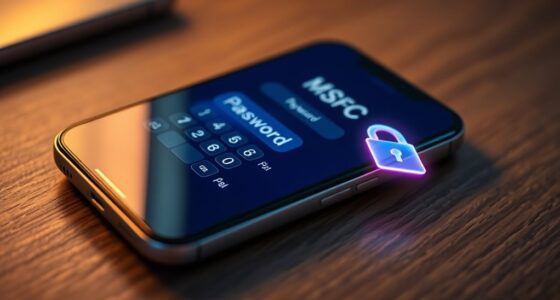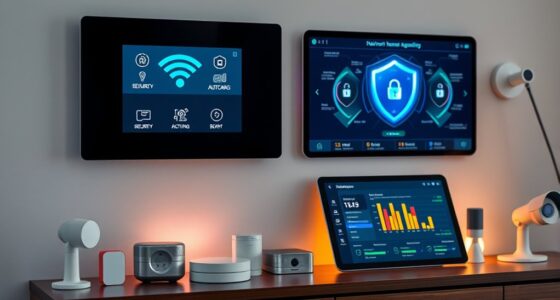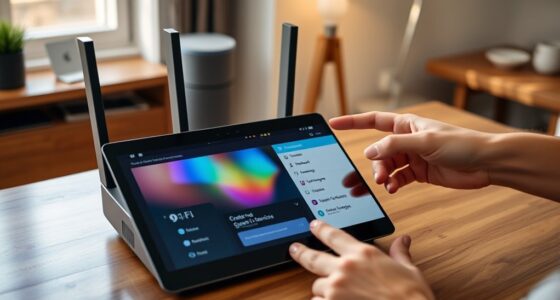Side-channel attacks on voice assistants are complex methods that exploit physical signals like sound, electromagnetic emissions, or power use to access private data. While they can theoretically expose sensitive information, most users aren’t at high risk because these attacks require specialized equipment and technical expertise. Your devices are generally secure with current security measures, but if you want to understand how to stay protected and the real level of threat, there’s more to uncover.
Key Takeaways
- Most side-channel attacks on voice assistants require specialized skills, equipment, and controlled environments, making them unlikely for casual attackers.
- Manufacturers implement encryption and hardware security measures to protect voice data, reducing the risk of successful side-channel exploits.
- The actual threat level for average users remains low due to the technical complexity and physical proximity needed for such attacks.
- High-value targets may face more sophisticated threats, but general privacy risks from side-channel attacks are minimal.
- Staying updated with security patches and managing device permissions significantly lowers the already low risk of exploitation.
Understanding Side-Channel Attacks and How They Work

While side-channel attacks might sound complex, they fundamentally involve analyzing indirect signals emitted by a device to uncover sensitive information. These attacks exploit cryptographic vulnerabilities by observing hardware leakage, such as power consumption, electromagnetic emissions, or timing information. When a voice assistant processes commands, it unintentionally leaks data through these channels. An attacker can measure these signals to infer secret keys or private data, bypassing traditional security measures. Unlike direct hacking, side-channel attacks focus on physical emissions, making them subtle yet powerful. Understanding how hardware leakage reveals cryptographic vulnerabilities helps you grasp the risks these attacks pose. By analyzing these indirect signals, attackers can compromise voice devices without directly accessing their software, highlighting the importance of securing hardware components against such exploits. Additionally, knowledge of residency requirements can help understand how physical presence or access might influence security vulnerabilities in hardware devices.
Common Types of Side-Channel Attacks Targeting Voice Devices

Several common types of side-channel attacks specifically target voice devices, exploiting their hardware emissions to gather sensitive information. One method involves analyzing the audio signal produced by the device, which can inadvertently reveal spoken commands or voice patterns. Attackers listen for subtle variations in sound waves that correlate with specific inputs. Another prevalent attack focuses on electromagnetic emanations emitted by the device’s hardware components. These electromagnetic signals can be intercepted and analyzed to reconstruct what the device is processing, including sensitive audio data. Both techniques rely on capturing emissions during device operation, bypassing traditional security measures. Supporting security by understanding these attack vectors, you can better appreciate how seemingly innocuous signals—whether audio or electromagnetic—can compromise your voice assistant’s security.
How Attackers Can Exploit Voice Assistant Hardware and Software
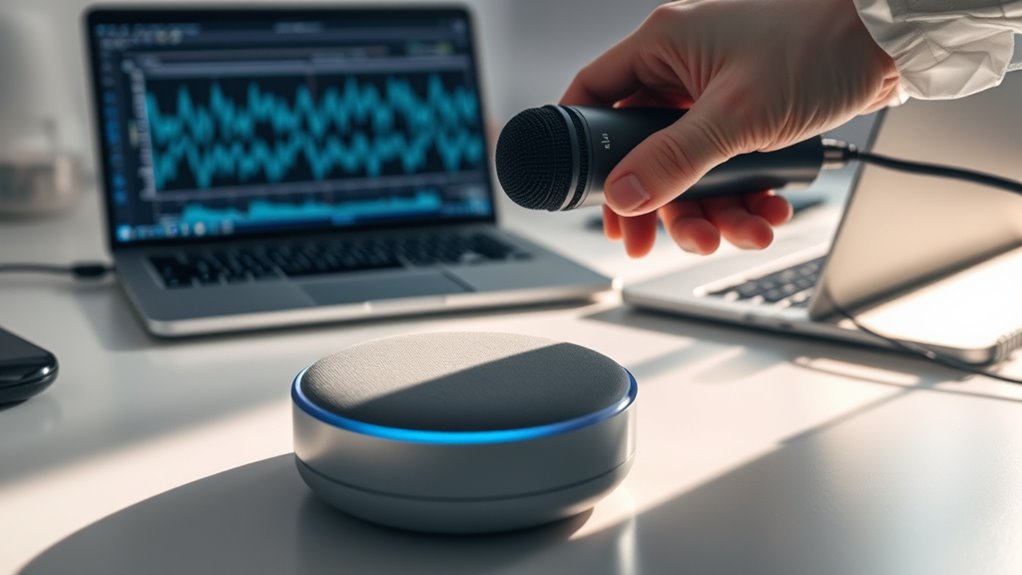
Attackers can exploit both the hardware and software of voice assistants by deliberately manipulating or analyzing their components to extract sensitive information. They target hardware vulnerabilities or analyze voice data patterns to uncover private details or commands. For example, attackers might use electromagnetic signals or power analysis to monitor internal processes, revealing voice commands or user habits. Software exploits include injecting malicious code or exploiting firmware flaws to access stored voice data. Here’s a quick overview of common attack methods:
| Exploit Type | Target Area | Potential Outcome |
|---|---|---|
| Electromagnetic Analysis | Hardware components | Voice data leakage |
| Power Analysis | Hardware vulnerabilities | Sensitive info extraction |
| Firmware Exploits | Software vulnerabilities | Unauthorized access to data |
| Acoustic Side-Channel | Microphone hardware | Voice pattern leakage |
| Software Injection | Voice assistant software | Command hijacking or data theft |
Additionally, researchers highlight that side-channel attacks can be particularly effective due to the subtle nature of these exploits.
Real-World Incidents of Side-Channel Exploits on Voice Assistants

Real-world incidents have demonstrated how side-channel vulnerabilities in voice assistants can be exploited to compromise user privacy. Attackers have used voice command vulnerabilities to infer sensitive information, revealing what users say or do without their knowledge. For example, researchers demonstrated how analyzing audio patterns could identify specific commands, exposing data leakage concerns. In some cases, malicious actors exploited slight variations in sound to trigger unintended actions or extract personal details. These incidents highlight that even seemingly harmless voice interactions can be exploited to gather private data, raising alarms about the security of voice-enabled devices. Such exploits show that side-channel attacks on voice assistants are not just theoretical but pose real risks to your privacy and data security. Additionally, understanding the security implications of voice assistant design can help users better protect their information against such exploits.
The Risks to Your Personal Privacy and Data Security

How vulnerable is your personal privacy when using voice assistants? Your voice data can be intercepted or analyzed through side-channel attacks, exposing sensitive information like your habits, routines, or even passwords. These attacks exploit hardware vulnerabilities, such as electromagnetic emissions or power consumption patterns, which can reveal what your device is processing. If hackers access this data, they can compromise your security or sell your voice data to third parties. Even with encryption, hardware vulnerabilities can bypass safeguards, making your conversations and personal details susceptible to spying. Every command you give could potentially be monitored without your knowledge. This highlights the importance of understanding the risks and ensuring your devices are protected against these sophisticated threats.
Measures Manufacturers Are Taking to Protect Users
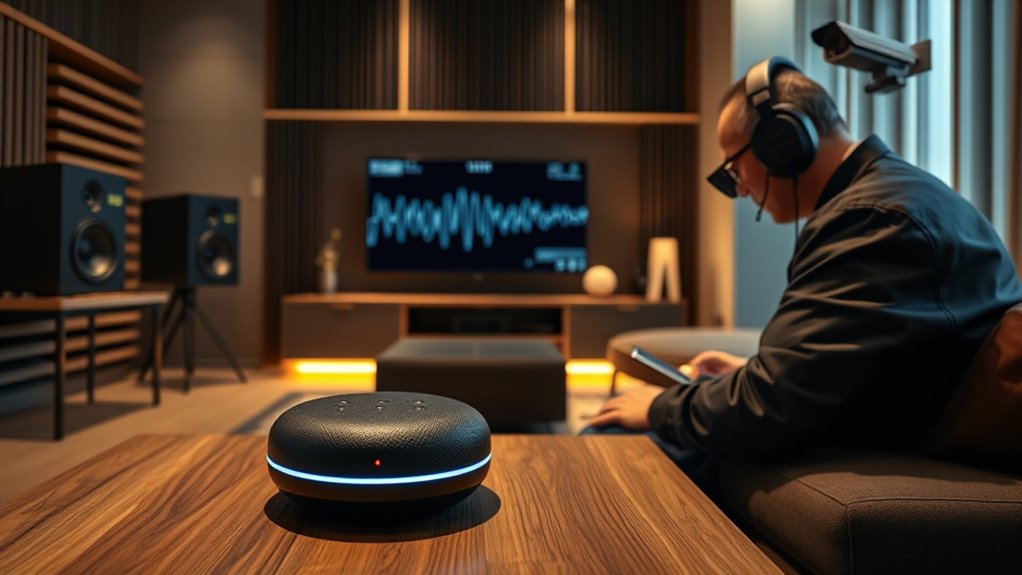
To combat the vulnerabilities exposed by side-channel attacks, manufacturers are implementing a range of security measures designed to safeguard user data. One key approach is enhancing voice biometric systems to better verify identities and detect anomalies that may indicate tampering. They’re also employing advanced data encryption techniques to protect voice recordings and command data both in transit and storage. These encryption methods ensure that even if attackers access intercepted signals, they can’t decipher sensitive information. Additionally, some manufacturers are introducing hardware-based security features that isolate voice processing components, reducing exposure to side-channel attacks. Vetted – Halloween Product Reviews By combining biometric safeguards with robust encryption, these measures aim to make it markedly harder for attackers to exploit vulnerabilities and compromise your voice assistant’s security.
Practical Tips to Enhance Your Voice Assistant Security

To protect your voice assistant from side-channel attacks, start by strengthening voice authentication to make certain only you can access it. Manage device permissions carefully, giving apps and services only the access they truly need. These steps can considerably boost your overall security and keep your information safer. Additionally, staying informed about AI vulnerabilities can help you understand potential risks and adopt appropriate safety measures.
Strengthen Voice Authentication
Are you aware that voice authentication systems can still be vulnerable to sophisticated attacks? Strengthening your voice biometrics enhances user verification and reduces risks. Use multi-factor authentication, combining voice with PINs or passwords. Regularly update your device’s software to patch vulnerabilities. Consider adding a secondary voice profile for sensitive commands.
| Tip | Benefit |
|---|---|
| Multi-factor auth | Boosts security against spoofing |
| Regular software updates | Fixes known vulnerabilities |
| Secondary voice profile | Prevents unauthorized access to sensitive info |
| Use complex passphrases | Adds an extra verification layer |
Manage Device Permissions
Managing device permissions is a critical step in safeguarding your voice assistant from unauthorized access. By carefully controlling app and device permissions, you reduce the risk of voice command vulnerabilities that could be exploited by attackers. Regularly review which apps have access to your microphone, camera, and other sensitive features, and revoke permissions that aren’t necessary. This limits potential entry points for malicious actors aiming to intercept or manipulate voice commands. Effective device permission management ensures your voice assistant only interacts with trusted apps and services, minimizing the chances of side-channel attacks. Staying vigilant about permissions helps protect your privacy and keeps your voice commands secure from prying eyes and ears. Additionally, understanding affiliate disclosures helps you make informed decisions when researching security tools or related products.
The Likelihood of Being Targeted by a Side-Channel Attack
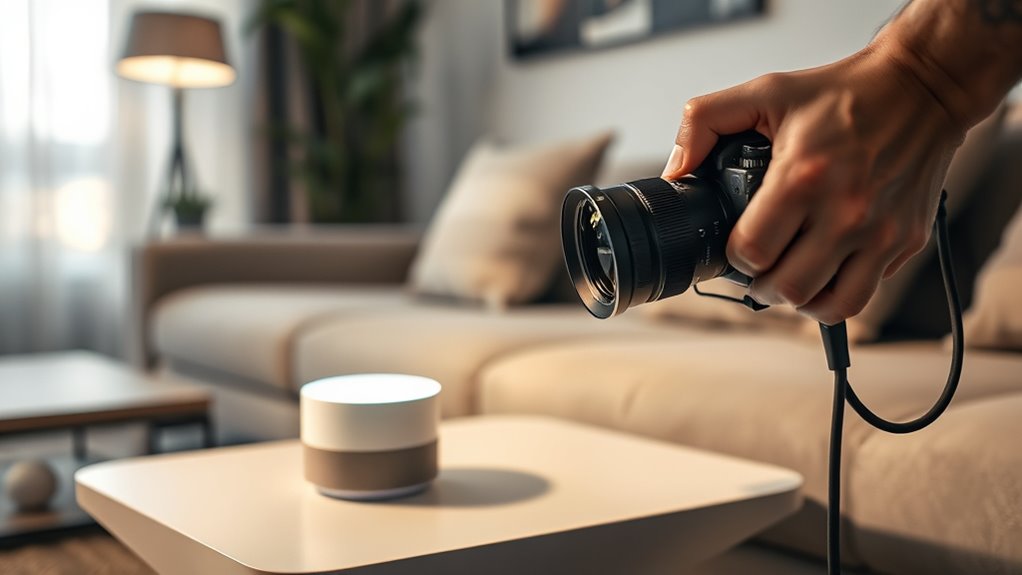
Your risk of facing a side-channel attack depends on the attacker’s skill level and your device’s security features. While highly skilled hackers are less common, frequent targeting is unlikely unless you hold particularly valuable information. Understanding these factors helps you assess how vulnerable your voice assistant truly is. Incorporating mindfulness practices can help you stay aware of potential security risks and maintain a cautious approach to device usage.
Attack Skill Requirements
The likelihood of being targeted by a side-channel attack on voice assistants largely depends on the attacker’s skill level and resources. If the attacker has high expertise and access to advanced tools, they can exploit even simple voice commands to gather sensitive data. Conversely, complex voice commands can make attacks more difficult, requiring specialized skills to analyze subtle acoustic patterns or timing cues. Your user awareness also plays a role: understanding how voice data might be vulnerable can help you adopt safer habits, like avoiding sensitive conversations near devices. While skilled attackers can target any user, the complexity of your voice commands and your awareness of privacy risks influence how easily you might become a target. Overall, attack skill requirements vary, but vigilance remains essential. Additionally, understanding audio signal characteristics and how they can be exploited is crucial for assessing potential vulnerabilities.
Device Security Measures
Device security measures substantially influence the likelihood of a voice assistant being targeted by side-channel attacks. If your device has strong encryption and safeguards against cryptographic vulnerabilities, it’s less likely to reveal sensitive information through side channels. Regular updates and patches help close security gaps that attackers might exploit. User awareness also plays a critical role—being cautious about enabling unnecessary features or sharing sensitive data reduces your risk. Devices with robust security protocols are harder for attackers to analyze through side-channel methods, lowering your chances of being targeted. Conversely, lax security measures and unpatched vulnerabilities increase vulnerability. Staying informed about your device’s security features and applying recommended updates can considerably decrease your risk of a side-channel attack.
Attack Frequency Likelihood
While not all voice assistants face the same level of threat, the likelihood of being targeted by a side-channel attack depends heavily on various factors such as device popularity, security measures, and attacker motivation. Popular devices with large user bases are more attractive targets because attackers can maximize impact and potential data gains, threatening user privacy. Additionally, device vulnerabilities increase your risk; if your voice assistant has weak security features, it becomes easier for attackers to exploit side channels. Attackers are often motivated by financial gain or espionage, making high-profile devices more attractive. While the overall probability may seem low for individual users, those with vulnerable devices or high-profile targets face a higher likelihood of being targeted by side-channel attacks.
Future Trends and Evolving Threats in Voice Assistant Security
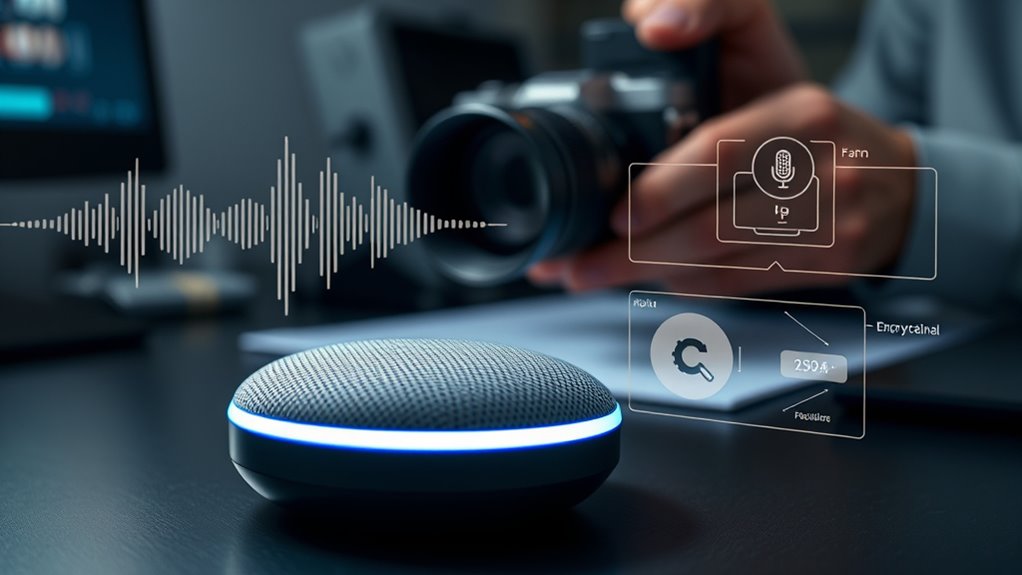
As voice assistants become more integrated into daily life, attackers are likely to develop increasingly sophisticated side-channel methods to exploit them. Future threats may target voice biometrics, attempting to mimic or manipulate vocal patterns to bypass authentication. Attackers might also analyze subtle acoustic signals or device emissions to extract sensitive information, even when data encryption is in place. As encryption techniques evolve, adversaries will seek vulnerabilities in the implementation rather than the algorithms themselves, exploiting hardware or software flaws. Additionally, advances in machine learning could enable attackers to better interpret side-channel data, making it harder to distinguish genuine voice commands from malicious interference. Staying ahead requires continuous improvements in security measures, including robust voice biometrics and layered data encryption strategies. Understanding hardware vulnerabilities can help in developing more resilient security solutions against emerging threats.
Should You Be Concerned? Weighing the Actual Risks
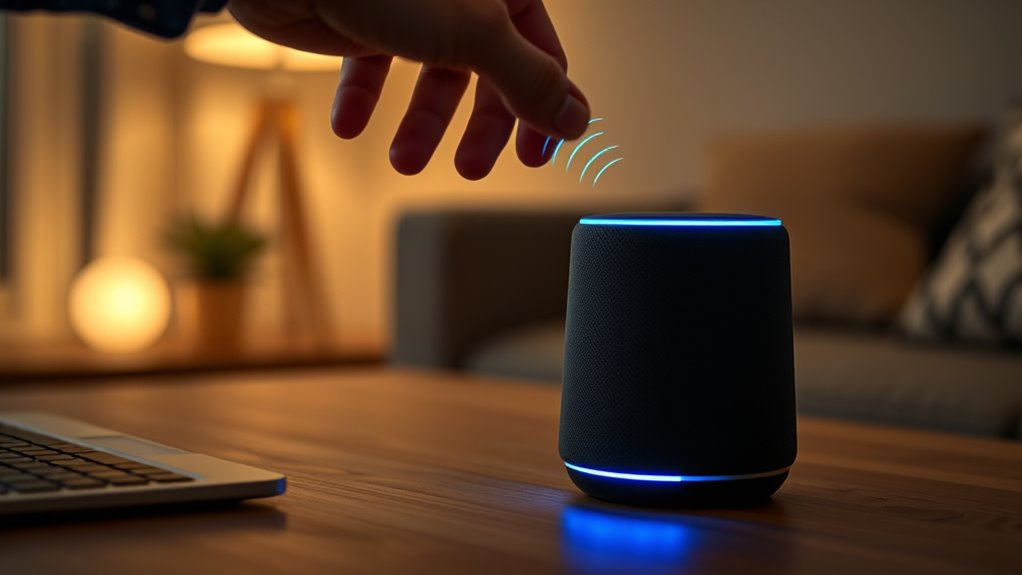
While side-channel attacks on voice assistants are technically possible, the actual threat level remains low for most users. Attack feasibility is limited by the need for close proximity and specialized equipment, making widespread attacks unlikely. Still, it’s important to understand the privacy protections in place and take simple steps to enhance your security.
Actual Threat Levels
Are voice assistants truly vulnerable to side-channel attacks, or is this threat often overstated? While some risks exist, the actual threat level is relatively low for everyday users. Attackers face considerable challenges, such as encryption vulnerabilities and the need for proximity or specialized equipment. To visualize, imagine this grid:
| Attacker’s Goal | Required Resources | Likelihood |
|---|---|---|
| Extract sensitive info | Advanced tech | Rare |
| Eavesdrop via sound | Close proximity | Low |
| Use device flaws | User awareness | Moderate |
Most attacks demand technical expertise and physical access. Your awareness of device security, combined with proper encryption measures, considerably reduces risks. So, while not impossible, side-channel attacks on voice assistants aren’t a widespread concern for the average user.
Attack Feasibility Concerns
Although side-channel attacks on voice assistants are technically possible, the reality is that they pose a limited threat to everyday users. These attacks often require sophisticated equipment and expertise, making them unlikely for most threat actors. Hardware vulnerabilities could be exploited, but such exploits are rare and typically targeted at high-value targets.
You should consider these factors:
- Successful voice recognition attacks depend on precise audio cues and environmental control.
- Hardware vulnerabilities are difficult to exploit without physical access or advanced tools.
- Most side-channel techniques need specialized equipment, limiting their accessibility for casual attackers.
Privacy Protection Measures
Given the technical hurdles and the specialized equipment required for successful side-channel attacks on voice assistants, most users face a low personal risk. To protect your voice data from hardware vulnerabilities, manufacturers implement security measures like end-to-end encryption and secure hardware modules. You can also take steps such as disabling voice activation when not in use or limiting device permissions. Here’s a quick overview:
| Measure | Effectiveness | Implementation Tips |
|---|---|---|
| Firmware updates | Fix hardware vulnerabilities | Regularly update voice assistant firmware |
| Voice data encryption | Protects transmitted info | Enable encryption settings |
| Physical device security | Prevents hardware tampering | Keep devices in secure locations |
| User controls and permissions | Minimize data exposure | Review app permissions regularly |
These protections markedly reduce risks associated with hardware vulnerabilities and voice data exposure.
Frequently Asked Questions
How Common Are Side-Channel Attacks on Everyday Voice Assistant Users?
You probably don’t need to worry much about side-channel attacks on your voice assistant, as they’re still quite rare for everyday users. These attacks often exploit hardware vulnerabilities and require sophisticated methods to bypass encryption protocols. Most voice assistants have security measures in place, making such attacks difficult and unlikely to happen to you without targeted effort. Stay updated on security practices, but overall, your device remains relatively safe.
Can My Voice Commands Alone Be Used to Compromise My Device?
You wonder if your voice commands alone can compromise your device. While it’s unlikely, cryptographic vulnerabilities and hardware leakage can be exploited through sophisticated side-channel attacks, potentially revealing sensitive info. Hackers might analyze your device’s power consumption or electromagnetic signals to infer commands or data. However, these attacks require advanced skills and specialized equipment, making them rare for everyday users. Stay cautious, but don’t panic—your voice alone isn’t a common threat.
Are There Specific Voice Assistant Models More Vulnerable to These Attacks?
Some voice assistant models are more vulnerable to attack techniques due to model vulnerabilities. For example, older or less secure devices often lack advanced protections, making them easier targets. Attackers can exploit these vulnerabilities using specific attack techniques like audio signal analysis or command injection. To stay safe, you should keep your device updated and consider security features, as newer models tend to have better defenses against such threats.
What Signs Indicate My Device Has Been Targeted by a Side-Channel Attack?
If you suspect your device has been targeted, watch for signs like unexpected noises or strange sounds during use, which could indicate interference. You might also notice unauthorized recordings or unrecognized commands. These signs suggest someone could be trying to access your data or eavesdrop. Stay alert to unusual activity, and consider updating your device’s security settings or resetting it to protect your privacy from potential side-channel attacks.
Do Software Updates Fully Eliminate the Risk of Side-Channel Exploits?
Software updates help reduce the risk of cryptographic vulnerabilities, but they don’t fully eliminate side-channel exploits. Attackers often target hardware vulnerabilities that require specialized hardware countermeasures, which updates alone can’t fix. While updates improve security, you should also consider hardware protections and best practices to minimize risks. Staying informed about new threats and applying both software and hardware security measures keeps your devices safer from sophisticated side-channel attacks.
Conclusion
While side-channel attacks on voice assistants are technically possible, they’re not everyday threats for most users. Staying informed and following simple security tips can greatly reduce your risk. Do you really want to leave your personal data vulnerable to unseen exploits? Probably not. By understanding these risks and taking proactive steps, you can enjoy your voice assistant safely and securely—without constantly worrying about hidden threats lurking in the background.

